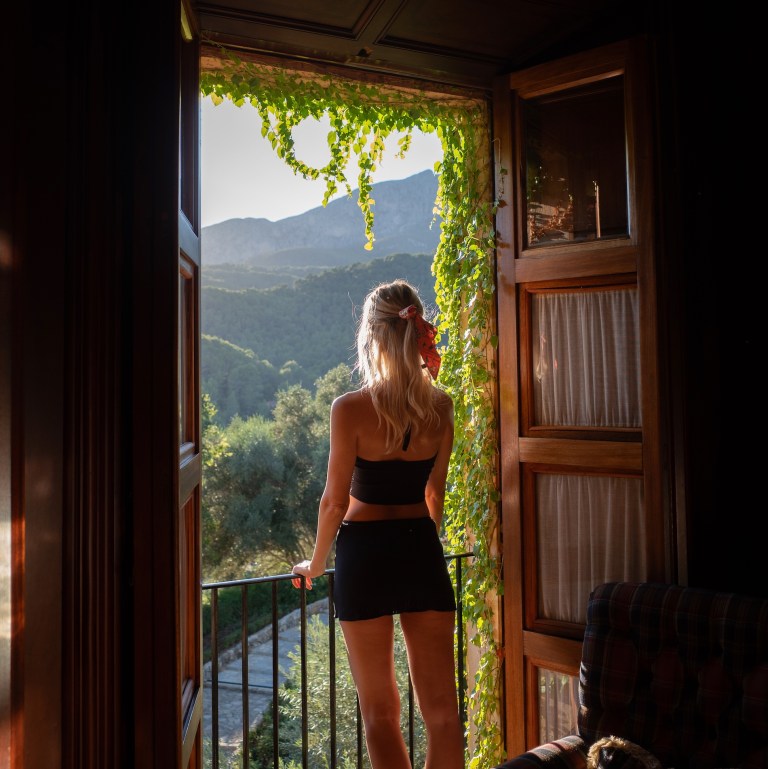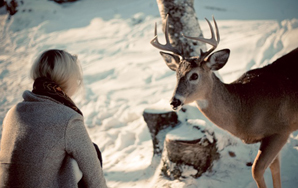
What To Expect When Trying To Live Your Life In The Woods
A cabin in the woods is a dream. Artists I know have described their forest fantasies at length.
By Kristel Jax
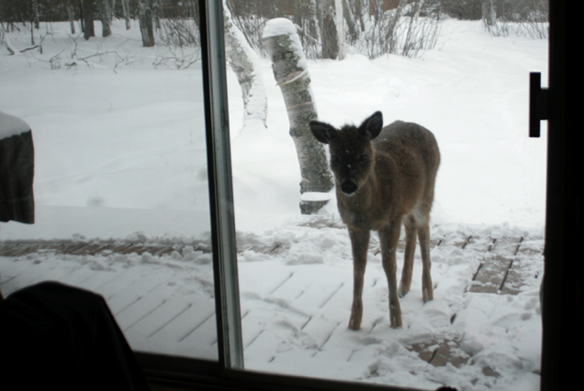
I recently moved into the woods. A log cabin on a nature preservation, to be exact. I’m one of the last people I thought would ever move here, as a few years ago I shivered at hearing that friends of friends, who were tired of urban density and noise, decided to move far away from Toronto to places like Guelph (not the woods). Everything I needed was between Yonge Street and Ossington Avenue. I couldn’t leave the city. At 19, I briefly ended up in the silent and majestic forests of Guatemala by accident, and almost went insane. Not only did I need the grid, I craved the hustle.
Now, six years later, I’m older, cynical and live with my partner in a three-room cabin where everything I need is located within our cabin’s outer walls. While it’s generally colder here than in the Siberian cities I’ve Googled, between bragging about deer eating out of my hand and complaining about having to wear a jacket indoors, I confess to friends back in Toronto that I’m not really roughing it. We have electricity, Wi-Fi and (sort of) electric heat. There’s like, an oven and a microwave. There’s also running water and a semi-functional shower, which, though I hate with all the furies, is still better than nothing. The tap water here is full of sand, but my paranoia about ingested grains eventually forming into rocks in my stomach — founded on a reality TV show I saw about a woman who ate rocks — is mild at worst.
A cabin in the woods is a dream. Artists I know have described their forest fantasies at length. I’ll go out on a limb and say all weirdo-beardos who give their bands names like The Wilderness of Manitoba want to live in the bush. There are Thoreau-toting fans from Istanbul to Tokyo to Kalamazoo all harbouring aspirations of being surrounded by nature instead of other terrible humans. My nature-loving parents, too, wanted to live off the grid, but I had to be in school.
To Canadians in particular, though, these dreams are somewhat different. What percentage of our country consists of untouched forest and ice — like 98%? With fracking, that’s maybe down to 80% now, but we can still feel the wild regardless of half the population’s politically non-conservational leanings. We can smell tundra, sense the trees. When I was young, I had a birthday party that was entirely based on jumping off riverbanks into snowdrifts. I read Farley Mowat books, and I bet you did, too. The Dog Who Wouldn’t Be, Never Cry Wolf, People of the Deer — yeah, you probably read those. You’re Canadian. I bet even Drake read Owls in the Family when he was like, eight.
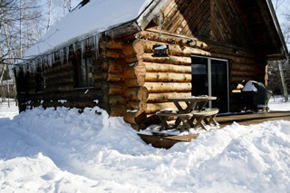
While “I’m going to live in the woods” is the Canadian equivalent to the American’s “Fuck it, I’m moving to Canada,” it’s also something more. There’s a belief we could actually do it if we didn’t have to work or wouldn’t miss our family and favourite bar, which looks like a cabin inside anyway. The forest is our right, and there’s plenty to go around. We could live in an igloo and be okay, but for now we’re choosing not to. For Canadians, getting back to nature isn’t a quaint idea or a metaphor for dropping out of capitalism’s rat race, but rather an option, like retirement was for people born before the 1950s. Living in a shack as a bearded, Bay blanket-draped recluse is on the table between the No Name brand maple syrup and bag of ketchup chips.
As a realized Great White North Forest Dweller, I can tell you that any moving-into-the-woods experience will be different, and one should forecast his or her own woodland odyssey based on three factors: finances, temperament and depth — depth being distance into the wilderness (is there cell phone coverage?). For instance, I’d rate my own woods-depth at six out of 10, where one is a penthouse at the intersection of Toronto’s Bay and Bloor, five is a highway address with good plumbing outside of a small northern town where no one’s ever used the phrase “public transit,” never mind had access to it, and 10 is eating tree bark three hours by plane from Whitehorse.
Financially speaking, I’m broke. (Hi, everyone else!) This impacts my ability to buy supplies, but has also messed with forest life in ways I couldn’t have imagined. For instance, to save money on having our septic tank emptied — $85 a call — doing dishes now means multiple trips outside, snow or shine, to dump dishwater out onto a tiny ice rink we made in the yard. Saving money has never been so adorable. We also can’t afford the gas to drive into town more than once a month, and the heat stays on low any wonderful day when the temperature rises above -15°C. When we do venture back to town, I resist buying cool things that would make life easier, such as extra antifreeze for the shower, luxurious thrift-store woolen products and stockpiles of five-cent candy.
Which brings me to the most unforeseeable necessity of giving up on society: temperament. What you need to stay sane in the woods might be shocking, embarrassing and downright unpatriotic. After four weeks in shared solitude, an assortment of items I regarded as necessities became the basis of my immediate identity. Currently, the building blocks of my sanity are a handful of teeth-destroying candy, lots of herbal tea, a crunchy snack food option (when I ran out of cucumber I resorted to air-popped popcorn), daily banter with someone other than my partner (thank you, internet) and cartoons (I studied animation until the recession hit). Could I train myself to live without these things? I imagine so, but do I want to try? Apparently not.
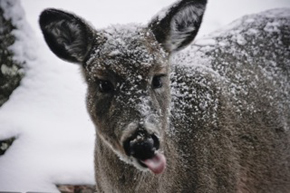
My most crucial emotional limit, though, is after seven nights without a shower. I lose all desire to live. I feel prissy about this, since I’m in a touring band and like, live in the forest, but while after six nights I’m okay, after seven I’m freaking out. “Just have a shower, filthy creep,” you might think, but it’s not that simple. While other pipes are doing a-okay whether it’s 0°C or -35°C (this is real), the shower’s drain is impossible to predict. I never know if I’ll be able to have a normal, relaxing shower, or if I’ll have to rush to finish before the water starts spilling over the seven-centimetre-high sides of the shower basin because the pipes aren’t working. Will the antifreeze poured hopefully down the drain do its job, or will a concoction of water-sand-antifreeze rise up into the basin? Is this a First World complaint, or Second?
When the cabin shower doesn’t drain, we bail the basin with bowls and dump the excess water onto the ice rink outside. I started putting food colouring in the water in hopes of making pretty ice art, but so far the result is less a combination of Farley Mowat’s outdoorsy-ness with a Martha Stewart-like sensibility, and more a child’s post-birthday party sprinkle barf. (This part is definitely a First World issue.)
Depth-wise, my own fortress of solitude isn’t textbook isolated: there are dozens of other properties within a ten minute’s walk, and this winter at least a few of them are inhabited. Some days I’ll see a car or two drive by on the road, and I hear snowmobiles often. I once saw two tiny, fluffy pomeranians hanging around on somebody’s driveway. Roads are plowed after blizzards and, weather depending, we can drive an hour to the nearest town for laundry and supplies. If the Canadian dream is eating wild mushrooms and making bannock over a wood stove 100 kilometres from a phone, I’m the first to admit my experience is the Canadian idyll.
Friendly deer, random animal sightings, not having to talk to strangers — this is the life Mowat promised. Other aspects of cabin-living, however, are caught in a fog of what’s the woods and what’s just being unemployed. If I didn’t have to pay rent, couldn’t I have just hoarded supplies and surfed the internet from my last place in West-West-West Toronto, which often felt like the edge of the world anyway? Beyond knowing I can’t impulsively go out to browse books, meet friends or purchase ketchup chips, the difference seems slight. Cabin fever is real, and can involve despair, fighting over nothing, sleeping a lot or a mixture of all three. Yet urban depression is more or less the same.
Whenever my partner and I have to drive now, I think about the real cost of leaving the city. Like, okay, driving in the woods at night during winter is the worst fucking thing ever. We hit a deer on the highway in January. It ran into the driver’s side of the car — or rather, the car ran into the deer — before it bolted back into the woods, but possibly not making it very far. While I can’t speak for those living north of Timmins, Ontario, in lean-to shacks chopping wood, the true price of cutting off from society seems massive compared to what I imagined it would while safe in the city. Car repairs, comfort foods, gasoline, nervous compulsions, guilt, deer-maiming and monopoly-controlled sewage removal all add up. Our forest adventure sometimes involves crying sandy, antifreeze-tainted tears, but I’m into it — at least for the time being. I’d have to make some serious changes to fight the good fight in the woods forever.
We only have a few months of #forestlife left to go. The voice in my tourist-hating brain that is as hard on me as I am on society says Mowat would be ashamed of this Twitter-using, car-driving, noncommittal approach to going wild, yet I believe he’d also understand and even sympathize with our time eating candy among the deer. As that other nature master, Jack London, once said: “I’d rather sing one wild song and burst my heart with it, than live a thousand years watching my digestion and being afraid of the wet.” We’re trying. Can someone send me a Brita filter? ![]()

